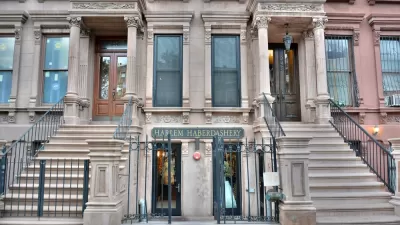The program gives households a rent subsidy that can be used flexibly over time, making it a valuable tool for workers with fluctuating incomes.

In a report for the Urban Institute and The Lab @ DC, Josh Leopold, Mychal Cohen, Maria Alva, Nat Mammo, and Sam Quinney evaluate the impact of the city's flexible rent subsidy program on housing stability in the District. "Flexible rent subsidies are one tool local governments are exploring to help families that are currently housed but remain one shock away from homelessness. A flexible subsidy allows families to decide how much of the subsidy to spend each month, up to their total rent. This flexibility can be particularly valuable for workers whose earnings fluctuate, such as seasonal workers and those in the 'gig' economy, who have been especially hard hit this past year."
D.C.'s program, DC Flex, "gives families $7,200 a year for rent to use whenever they need" and "was designed to fill a niche for families who do not need the case management offered in typical homeless assistance programs but who do need a subsidy to reliably afford rent and avoid homelessness."
"A review of the DC Flex account data showed 60 percent of program participants spent the full $7,200 over the course of the year, and others preserved funds for their second year in the program. This result suggests participants use the program’s flexibility to suit their specific financial needs." According to the study's authors, "[t]his is the moment for trying and testing flexible subsidies more broadly, and the DC Flex program is a promising example of how these programs can be structured."
FULL STORY: DC’s Flexible Rent Subsidy Program Shows Promising Early Results

Alabama: Trump Terminates Settlements for Black Communities Harmed By Raw Sewage
Trump deemed the landmark civil rights agreement “illegal DEI and environmental justice policy.”

Planetizen Federal Action Tracker
A weekly monitor of how Trump’s orders and actions are impacting planners and planning in America.

The 120 Year Old Tiny Home Villages That Sheltered San Francisco’s Earthquake Refugees
More than a century ago, San Francisco mobilized to house thousands of residents displaced by the 1906 earthquake. Could their strategy offer a model for the present?

In Both Crashes and Crime, Public Transportation is Far Safer than Driving
Contrary to popular assumptions, public transportation has far lower crash and crime rates than automobile travel. For safer communities, improve and encourage transit travel.

Report: Zoning Reforms Should Complement Nashville’s Ambitious Transit Plan
Without reform, restrictive zoning codes will limit the impact of the city’s planned transit expansion and could exclude some of the residents who depend on transit the most.

Judge Orders Release of Frozen IRA, IIJA Funding
The decision is a victory for environmental groups who charged that freezing funds for critical infrastructure and disaster response programs caused “real and irreparable harm” to communities.
Urban Design for Planners 1: Software Tools
This six-course series explores essential urban design concepts using open source software and equips planners with the tools they need to participate fully in the urban design process.
Planning for Universal Design
Learn the tools for implementing Universal Design in planning regulations.
Clanton & Associates, Inc.
Jessamine County Fiscal Court
Institute for Housing and Urban Development Studies (IHS)
City of Grandview
Harvard GSD Executive Education
Toledo-Lucas County Plan Commissions
Salt Lake City
NYU Wagner Graduate School of Public Service





























